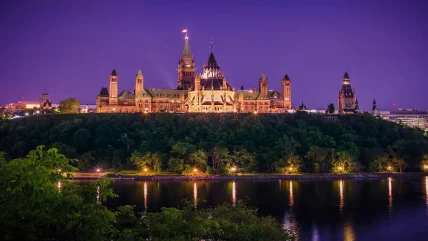
There are many single urban areas with multiple, competing local identities: from the rivalry of Newcastle and Sunderland in Tyne & Wear, to the Wolverhampton residents who resolutely deny that they are part of Birmingham, despite being in the same urban conurbation and sharing a mayor.
However, no division is quite as stark as that of the Ottawa-Gatineau metropolitan area in Canada. Often referred to as the National Capital Region, Ottawa and Gatineau lie directly opposite each other on either side of the Ottawa River, a hundred miles from Montreal, the nearest other significant population centre. Because the conurbation straddles a provincial boundary, the two cities literally speak a different language, with Ottawa in predominantly Anglophone Ontario and Gatineau in Francophone Quebec.
This is reflected in their populations. According to the 2011 census, French was the mother tongue of 77 per cent of those in Gatineau, a percentage maintained by policies intended to keep French as Quebec’s dominant language. Similarly, although Ottawa provides some bilingual services, 68 per cent of its residents are predominantly Anglophone; Franco-Ontarians frequently complain that the city is not officially bilingual.
Although there are similar divided cities, such as the Cypriot capital of Nicosia, Ottawa-Gatineau is unique in that the city was not divided by a war or major political event: its two halves have been part of the same political territory since the British defeated the French in the Battle of the Plains of Abraham in 1759, before either of the cities were even established. Indeed, the oldest part of Gatineau is actually an Anglophone settlement with the name of Hull (it was merged into the Gatineau municipality in 2002).
Today, the two cities facing each other across the Ottawa river have separate services, and elect difference mayors to run them: OC Transpo serves Ottawa, the Société de Transport de l’Outaouais (STO) serves Gatineau, and few tickets are transferrable between the two systems.
OC Transpo is currently constructing a light rail system to many parts of Ottawa; but proposals to expand the route into Gatineau, or to merge the two transport systems have been fraught with obstacles. The City of Ottawa owns a disused railway bridge, connecting the two cities, but arguments about funding and political differences have so far prevented it from being used as part of the light rail extension project.
The divisions between Ottawa and Gatineau are made all the more unusual by the fact that Ottawa is the federal capital of Canada – a country where bilingualism is entrenched in the Charter of Rights & Freedom as a bedrock principle of the Canadian constitution. As a result, while all proceedings within the Canadian legislature are bilingual, this principle of bilingualism is not reflected on the streets surrounding the building.
These linguistic, as well as political, differences have been a long-running theme in Canadian politics. Quebec held independence referendums in both 1980 and 1995; in the latter, the separatists were defeated by a margin of less than 0.6 per cent. Quebecois independence would be made all the more humiliating for Canada by the fact it would be losing the Canadian Museum of History in Gatineau, while its parliament was forced to look out across the river at its new neighbours.
While Quebec as a whole only narrowly rejected independence in 1995, 72 per cent of Gatineau residents voted against the separatist proposal. The presence of many federal employees living in the city, who commute to Ottawa, meant that the city was rather unenthusiastic about the prospect of independence.
So, with Quebec nationalism currently at a low ebb, Gatineau seems set to remain a part of Canada – albeit while retaining its independent from the other half of its conurbation, across the river. While recent challenges such as flooding may have been better tackled by a unitary authority, the National Capital Region seems set to remain a tale of two cities.
Want more of this stuff? Follow CityMetric on Twitter or Facebook.






